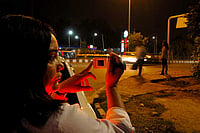“If you’re lonely when you’re alone, you’re in bad company.”—Jean-Paul Sartre
A four-and-a-half minute video spiked to instant popularity recently on social media. It’s on what psychologists say too much social media has spawned: too much loneliness. The animated video, The Innovation of Loneliness, by Shimi Cohen, illustrates how loneliness has become the “most common ailment of the modern world”. It points to a reason many New Age gurus, psychologists and hard-nosed pragmatists alike agree on: we have forgotten how to be alone and how to tolerate our fair share of boredom. We have set ourselves up to be lonely. That home truth attracted several thousands of ‘Likes’ and ‘Shares’ for the video.
Keval Patel of Ankleshwar is one of those who relates well to the message. The 23-year-old Twitter fan admits he is far more talkative and frank on networking sites than in person. When he takes a break from social media, he feels he is missing the action. “Online, nobody cares about my personality,” says the computer operator, who is comfortable in the anonymity of his online persona.
Meeting in person, people immediately scan their opposite for cues about class, educational background, career, family status, and, in India, even caste. Though a random, casual rudeness and crudity persists, that pinpointed scanning has no efficacy online—the aural/visual markers we use for it are no longer available. So, like many others, Patel feels liberated online: even when meeting friends over coffee, his attention is often on his phone updates, such is the pull. Most cyberjunkies do that: they find it easier to text or Whatsapp than call. They are connected on multiple platforms that show different sides of them, but like to be in control of how much they reveal and what they share; they have hundreds of friends online but find it difficult to draw up a guest list for an intimate get-together.

Dr Annsimi John, a psychologist at Columbia Asia in Gurgaon, isn’t surprised when clients seek sessions on Whatsapp. “I counsel couples who would rather communicate with each other over e-mail. I have young students too who text me whenever there is a crisis. Initially, I was hesitant to encourage this, but then I realised that maybe they are actually short of time, or it’s just their way of avoiding conflict in real time.” She narrates the case of a 17-year-old girl feeling emotionally abused by her mother. The teenager found relief in sending Annsimi messages on Whatsapp whenever she felt slighted. With the connection, the therapist was able to teach the teenager how to communicate more articulately and share her feelings with the mother. Some have even sharpened their communication using emoticons.
But that’s where we seem to be asking for trouble. At Mind Temple, a Mumbai counselling centre that sees an increasing number of patients facing issues related to isolation, Dr Anjali Chhabria, a psychiatrist, emphasises the need to acknowledge that the digital modes we use to express ourselves are, after all, passive. “It leads to one being expressive only on screens rather than sharing emotions in real. The result is a limited sense of belonging. When the person is used to communicating using technology instead of personal conversation, his experience in relating emotionally to others is in fact possibly diminished,” she explains. Bangalore-based Shilpi Choudhary, 29, a marketing and communications executive, feels lucky to have grown out of that phase. Last year, she realised she had a “Facebook obsession syndrome”—and blogged about it. One of her posts declares: “My addiction has grown to the extent I ignore people who have come over to my house to sneak out some time to be online, on Facebook. Sometimes I even go overboard—I go out to meet my long lost acquaintances from school/college so that I can talk about/post it on my timeline.” Says Choudhury now: “There comes a point when you realise you don’t need to update everything you do on Facebook, and thankfully, I got out of that phase. Even so, I feel young people are drawn to social media because they feel alienated in a society that refuses to have a dialogue with them. That’s why this generation often starts existing within their own microcosm online. As a result of the growing vacuum within, they try building a persona for themselves which everybody will love and aspire for.”
More often than not, say experts, this gambit ends up being counter-productive because most people tend to feel disconnected with their real selves, struggling as they are to maintain an alternate reality, the image they created for themselves on the web.

Helping hand Dr Chhabria uses a magnetic device that is claimed to help against depression. (Photograph by Amit Haralkar)
Dr V. Subathra, principal of Aiman College of Arts and Science for Women in Trichy, feels uneasy about this trend. In March, she led a study on the level of social network addiction among college students and found that it all comes down to a vicious circle. Social media, by seeming to cater to loneliness, feeds off it and feeds it in turn, leading to more loneliness. “About 75 per cent of students we interviewed were lonely. There’s fewer siblings, a breakdown of joint families, little communication there. I belong to the 1950s—we used to visit cousins, play games, visit neighbours. Now we lead a very restricted, solitary life. We have less tolerance for people around us,” says the professor. So we would rather be by ourselves, but not truly alone—there is always that digital best friend to reach out to.
The problem is, loneliness isn’t tangible as other ailments can be; neither is it exclusive to those who trawl the net for long hours. It’s at its simplest a byproduct of our chaotic times, a fractured urbanity already producing it. But loneliness and digital addiction are inextricably linked, a topic much researched and written about in the western world. Indian society, too, is gradually coming to grips with it. It’s so much a part of our New Age lifestyle that it escapes not even artistic expression. In Delhi, this week, at an Alliance Francaise gallery, installation artist Suchitra Gahlot explores this thought process through a rather elaborate medium. Her work of art, fittingly titled ‘Shut Up, Internet!’, makes a point about digital living through 60 suspended glass jars that contain 40,000 e-mails, all torn up, dating from 1995. Bits of paper fly to a controlled turbulence within each jar. “I had started introspecting on my own digital behaviour, which led me to believe that maybe we should step back and think for a moment, ‘Is it making our lives richer? How does it change us?’ You do see the impact of digital dependency all around you: withdrawal symptoms, social awkwardness. It’s easier, even at the dinner table, to look into your phone than look your companion in the eye. We’ve come so far that it doesn’t even upset people anymore if their fellow diners are busy taking pictures of the food through dinner. My work seeks to call for a balance.”

Suchitra Gahlot’s installation of suspended jars containing torn-up e-mails makes a comment on modern life. (Photograph by Sanjay Rawat)
According to Pune psychologist Geetha Suryanarayan, young introverts, or those who have social phobia and lack confidence, are more prone to falling prey to isolation. “These tools are intended to be used in moderation, but because of the multiplicity of these channels, something had to give. That something is meaningful, real-time relationships. So you seek instant gratification—Twitter being a great one for that—which leads you to believe you have a following hanging on to every word.” She speaks of a teenage boy who came to her with his father recently because he was hooked to his computer all night long. The net had become his sounding board. “From being a good student, he failed his exams. He was spending less time with real friends, felt suicidal. On the net, he created a fantasy world of the dark arts he wanted to pursue. He was losing touch with his present. In a larger sense, observes Delhi-based technology entrepreneur and social media professional Vinayak Garg, there is increasing alienation because even though you feel you are connected to hundreds of more people than say, 10 years ago, your interactions are not anything more than general small talk. “Earlier, an online presence was a reflection of what you did offline. It’s now the other way around—your offline actions are influenced by what you think you would want to portray online,” believes Garg. American social scientist Sherry Turkle, who studied how devices and online personas redefine human connection and authored the 2012 book Alone Together: Why We Expect More from Technology and Less from Each Other, sums it up best: “Being alone feels like a problem that needs to be solved.” You don’t need Google to tell you a simple fact: it really isn’t.
(Inputs by Arpita Raj and Lata Jha)


























